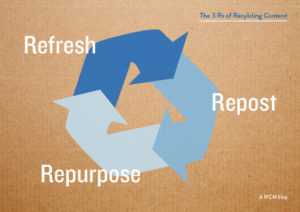
It’s a renewable world out there, and your content is no different. If you are limited in your resources to create new content, consider using the three R’s: Reduce, Reuse, Recycle, or in the case of content, Refresh, Repost, Repurpose, to help you save on resources and remain engaged with your audience.
There are many benefits to recycling content, including building your topical authority and increasing your site’s click-through-rate (CTR). Google also rewards the practice. Overtime, republishing content boosts your rankings and increases the chances of your piece being featured on the first page of search results.
After a year, look through old posts and articles to determine which pieces to update. Here’s a look at how you can use the three R’s for your business or organization.
Refresh
If you’ve cited a study from 2016, look for newer numbers and incorporate them into a new piece of content so the information remains timely and relevant to readers. As the industry evolves, continue to revamp your content to be topical and informed by current events and trends. Change up your headline with each tweet to encourage clicks and try phrasing it as a headline or a question first, and then a call to action.
Pro tip: Track which headlines garner the most engagement for future reference.
Repost
Publishing links on social media the day a new post goes live and following up thereafter is a good practice. However, different social platforms have varying standards for how often to post an update.
For instance, on LinkedIn, Instagram, and Snapchat, it is advised to post only when you first publish. Whereas on Facebook, post when you publish and follow up the next month. Twitter continues to be the fastest moving social media platform, so tweets often get buried. Plan to post to Twitter when you publish, two hours later, the following day, week, month, and two months.
Pro tip: Avoid reposting every piece of content to your blog. Strategically select pieces that have the potential to generate additional shares, are timely and important to your audience.
Repurpose
Look at your old content and think of it in new terms. Your old case study can become a “how to” article, which can later then become an infographic or 30 second video. This type of content can be stripped down and rebuilt with limited effort or resources.
Suppose you write a blog about 5 steps to a social media strategy. Take your original article and break it down into mini-blogs, expanding each step into individual blogs by topic to create a blogging series.
Visual learners make up 65 percent of the population, so the chances of your infographic or video resonating with your target audience is higher than that of a long-form article resonating —especially on social media. By reformatting data-heavy prose into an attractive and comprehensive set of graphs, charts and other visuals, you can make your content more digestible to a wider audience and increase its chances of being shared.
Pro tip: How to articles, list posts, and visual content including infographics and videos all do especially well on social media.
Let us know: Have you had success with recycling content?
